
The Strachan family came to Natal from Campbeltown on the Null of Kintyre in Scotland, Thomas Strachan being born there on 29th January 1838 and Donald Strachan the 22nd May 1840. Donald Strachan was only ten when their parents, Robert and Mary Strachan brought them to Natal under the infamous Byrne Scheme - aimed at settling the new British territorial claim of Natal. The family, who came across on the "Unicorn" was granted 60 acres of land in the Illovo district but found it unsuitable for farming or became a victim of Byrne's bankruptcy in 1850.
They settled in Durban where Robert Strachan, their father, was killed on 2nd February 1852 in a building accident.
The orphaned boys, twelve and fourteen were cared for by a faithful servant, Simon Rhadebe, who was later rewarded by Donald Strachan becoming a headman in the Umzimkulu District and his trusted adviser during times of conflict. The teenage boys were employed by James Kinghurst, the butcher in Durban, taking wagon trains from Durban to Pietermaritzburg and then Nomansland in the mid 1850s. Kingshurst was always in financial trouble and reneged on paying the young men when they left his employ.
By 1858 the boys had raised enough capital through other means to open a trading store near their farm Clydesdale at the Drift (later Umzimkulu) just across the Umzimkulu river in Nomansland. The evolving town that arose around the Strachan store had many names in the 1800s. It was originally called "Madonela" by the Africans who settled there in the late 1850s to be near the new trading post; Madonela meaning "the place of Donald". It was later called Clydesdale, the name of the Strachan's farm on maps published in the 1880s, - until finally being named Umzimkulu after the river in the late 1800s.
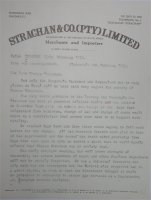 The
origins of the name "Umzimkulu" river are cemented in Zulu tradition.
"Umzi" means kraal or home, and "omkhulu" means which is big.
The home the Zulus referred to was the river - not a home as you would perceive
it. Legend has it that the river was given this name because in 1823 it swelled
to such a point that the Zulus could not pursue the Bhacas who were fleeing
King Shaka's feared army. One of the Zulu warriors said, while gazing across
the fast moving stretch of water that had stopped their pursuit, "Umuzi
Ubumkhulu" (the kraal -of water- has been great) and so the river became
known as Umzimkulu - the great river.
The
origins of the name "Umzimkulu" river are cemented in Zulu tradition.
"Umzi" means kraal or home, and "omkhulu" means which is big.
The home the Zulus referred to was the river - not a home as you would perceive
it. Legend has it that the river was given this name because in 1823 it swelled
to such a point that the Zulus could not pursue the Bhacas who were fleeing
King Shaka's feared army. One of the Zulu warriors said, while gazing across
the fast moving stretch of water that had stopped their pursuit, "Umuzi
Ubumkhulu" (the kraal -of water- has been great) and so the river became
known as Umzimkulu - the great river.
Image right: Strachan and Co letterhead
with transcript of newspaper article on the death of Thomas Strachan
(original document in the Balson Holdings Family Trust collection)
At the time the boys established their trading business in 1858 Donald was only eighteen years old and Thomas twenty. By the time the Griquas arrived in Nomansland in 1862 the boys' trading operation had become well established and accepted by the natives in the district.
Trade blossomed over the next ten years despite a major handicap - the need to barter without coinage and the great distances to markets to trade goods created a growing hurdle for the young boys and other traders in the area. Their income was supplemented when Donald Strachan was honoured with being the only white Magistrate appointed by the Griquas.
Background to Strachan and Company
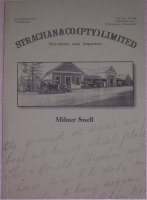 Image right: The extremely rare 100 page
history of Strachan and
Co written by Milner Snell of the Kokstad Museum (only thirty copies were
printed).
Image right: The extremely rare 100 page
history of Strachan and
Co written by Milner Snell of the Kokstad Museum (only thirty copies were
printed).
On the 13th January 1874 Thomas Strachan and George Charles Brisley established the trading store partnership of Strachan and Co with their first store handily placed at the upper Umzimkulu Drift - the site of the ferry from Natal to East Griqualand crossing the Umzimkulu river.
Donald Strachan maintained a very keen interest in the business taking over his brother, Thomas', share of the business after his untimely death in August 1879; Thomas broke his leg following a sawmilling accident near his property at Clydesdale and never recovered, dying in 1879 (see Strachan and Co scan of report of Thomas's death).
Following Thomas' death, Donald Strachan's position as Resident Magistrate at Umzimkulu coupled with his time consuming activities engaging his small private army the Abalandolosi, in confrontations with local hostile native tribes put an enormous strain on their fast growing business and his partner Charles Brisley. This pressure eventually led to their once great friendship becoming strained. When it appeared things could not get worse, they did. In 1882 a severe recession hit East Griqualand and many traders went out of business following the collapse of the local economy - the Strachan and Co trade tokens circulating East Griqualand as currency did just enough to keep the business afloat. The main cause of the economic collapse in South Africa at this time was over speculation in diamond shares following Rhodes and Barnato's battle to secure the big hole of Kimberley. Eventually the recession coupled with the growing rift between the business partners hit Strachan and Co very badly and in January 1887 the company was temporarily dissolved after Strachan and Brisley could not agree on how to pay the company's debts to the trading house Randles of Durban.
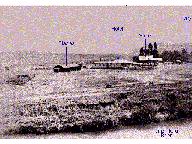 Image right: Umzimkulu
in 1883 - there is a large African township today where Strachan's main store
and hotel once stood alone on the banks of the Umzimkulu River.
Image right: Umzimkulu
in 1883 - there is a large African township today where Strachan's main store
and hotel once stood alone on the banks of the Umzimkulu River.
For three months Strachan and Co effectively ceased to trade but in April 1887 Donald Strachan revived the company with part of the company's indebtedness, by agreement, being left to George Brisley. Strachan was depending on the sale of a large tract of land at Lourdes to the Catholic Trappist Monks to fund his acquisition and pay his debts but found himself in a very deep hole as Brother Hudson refused to budge on an offer representing just 60% of the land's book value. Despite the enormous hurdles the company's trade tokens continued to be circulated and honoured by Donald Strachan.
Eventually Donald Strachan was forced to sell the land to the
Catholic Trappist Monks in late 1887 to avoid bankruptcy - the Monks paying
just £9,100 for a 50,000 acre block - earlier valued at £15,000 and today
worth millions. The valuable land, which allowed Donald Strachan to pay off his
debts, is still owned by the Trappist Monks who are also based at Mariannhill
near Pinetown (Natal). (Sources: "The Foundation of Lourdes
Mission" by Brother Nivard
- 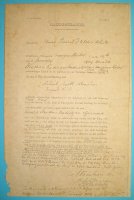 dated 17th
April 1895 and "Strachan and Co, Merchants and Traders" by Milner
Snell).
dated 17th
April 1895 and "Strachan and Co, Merchants and Traders" by Milner
Snell).
Over the next fifty years the business blossomed and under consecutive generations it grew into the trading empire of the region - with thirty stores spread across East Griqualand. The trade tokens playing a major part in the business' success. In 1986 the business was disbanded through the homeland policy which saw the transfer of white businesses in this region (now Transkei) being handed over to the African population. The trading stores and hotel at Umzimkulu were sold to individual black proprietors and are, sadly, today in a state of ruin.
Image right: The liquor licence granted
to Donald Strachan of Strachan and Company at Umzimkulu in 1904
The
document instructs Strachan not to allow "men or women of notoriously bad fame
to assemble on his premises"....
The only lasting legacy of this once great Strachan and Co trading store empire is their trade tokens.
Ken Strachan, who Scott Balson first met in 1976, told him that the trade tokens minted by his grand father, Donald Strachan, were inspired by the successful circulation of the 1860 Durban Club 6d. As Margaret Rainier notes on page 150 of her book "Madonela" that Donald Strachan stayed at the Durban Club when he visited Durban.
Douglas Strachan, the Managing Director of Strachan and Co from 1915 tells
us, "The first minting (of trade tokens) was, like the
others, done in England, and it is thought to have been prior to 1880, probably
as early as 1870. This was not a success as it had no hole near the rim and
could not be strung on a string round the owner's neck - the natives had no
purses in those days."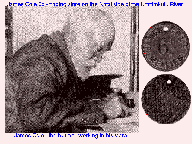
None of these first Strachan tokens, without the hole, have ever been found - if any were they would be extremely valuable. Like the first F C Larkan trade tokens it is highly likely they were made locally out of cardboard and not struck in England. Unlike the S&Co tokens they would not have reflected the partnership with Brisley. (ie They might, for instance, have had "Strachan" and a value hand written on the cardboard.)
Douglas continues, "This (first token) was soon replaced by the tokens showing values and the name "S & Co" - in 1874 when the company was launched. The third issue, printed like the second on one side only, had the additional letters "MH", these represent a branch of the company - "Mountain Home" - and were primarily intended for use there. The fourth and last issue are printed on both sides and have the words "In Goods" added. This series of tokens is said to precede those of James Cole (image right above) by many years and were in general use throughout this area and Southern Natal until withdrawn in about 1932. At least two separate strikes of the "In Goods" set were made.
"The first tokens with S&Co were accepted everywhere including church collections - but are seldom, if ever, seen these days." (The later S&Co "In Goods" sets were also widely used as currency in the region up until 1932)
| Image Right:
Donald Strachan with some of
his staff in 1906... Back Row L-R: Alexander "Bob" Greening (Umzimkulu Store); George Druce (the blacksmith and farrier); Thomas Wallace Strachan (ran the Umzimkulu store later); Frederick Strachan; Douglas Donald Strachan (took over running the business in 1915); Frank Hulley; Mr Howes; Mr McHugh (the barman at the Umzimkulu Hotel who was shot in 1909 by a member of the CMR). Seated L-R: "Doonie" McIntyre (Donald Strachan's cousin); Robert S Strachan*; Donald Strachan; Henry C Curson (Merchandise Manager); F G Pennales; E E Richer Front Row L-R: D Roussouw; Robert Mnini; Piet Nero; A G Adams (Rondedraai Store) and the dog "Bull" *Robert Strachan married James Cole's eldest daughter Kate. |
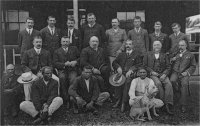 |

The first issue of the Strachan & Co coins
bearing the "S&Co" (seen above) were launched in 1874 - when the company was
first formed by Brisley and Strachan. This was over ten years before the
production of the "Afrikaner" ZAR coinage under Paul
Kruger used in the Oranje Vry Staat and the Transvaal and at the same
time as the Burgerspond was minted.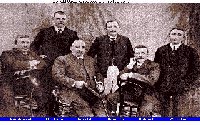
Image right: Donald Strachan and his sons.
It was only in the later years, probably in the early 1900s that the change
was made from trade token to barter token by the inclusion of the words
"In Goods". By then the S&Co tokens had become so popular as
an alternative currency that tens of thousands of these coins were struck. This
volume was obviously far more than was required for the sole purpose of trade at
their stores. At least two
strikings of the S&Co "in goods" tokens were made. It is interesting
to note that all other trading stores of substance followed Strachan's lead -
minting their own coins. Dr Theron's excellent (1978) book "Tokens of
Southern Africa and Their History" notes several including: F
C Larkan, James
Cole; St
Faiths; Dawood Amod; G Roe Scott; St Barnabus Anglican Mission; WW Phillips 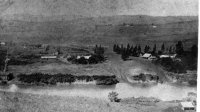 (Lurwayizo and Mendu);
Edward Sprag; and LP Moore - more varieties than the trading tokens struck in
the major city of Durban on the coast.
(Lurwayizo and Mendu);
Edward Sprag; and LP Moore - more varieties than the trading tokens struck in
the major city of Durban on the coast.
Image right: Historic photograph showing the landing spots for the two ferries at Umzimkulu c 1875
Importantly the sheer volume of token coins issued by the company runs into tens of thousands - far more than any other token in S Africa and just about anywhere else in the world. It is quite clear that their purpose went beyond that of trading alone - they were used as currency in the region for 50 years.
When the token coins were withdrawn from circulation in the 1930s they were collected and stored by Strachan and Co in small black metal containers in their Umzimkulu store for over 50 years. It was from this collection that my research and documentation was done nearly 50 years later. Interestingly, in recent years, large numbers of S&Co tokens have appeared - tokens that did not form part of that initial count made by Balson in the 1970s.
Ken Strachan told me that his grandfather, Donald Strachan, during a land buying spree in 1876 acquired the farm Mountain Home from Bishop Henry Callaway. The location of "Mountain Home" is interesting as Strachan, at this time, "swapped a number of the farms he bought for properties in better locations. He bought the farm Riverbank from Bishop Henry Callaway and had it resurveyed in a different position as Mountain Home, which was on a wagon route from Umzimkulu to Kokstad." (Source: pp 15 "Strachan and Co Pty Limited by Milner Snell)
Rupert Jackson, Strachan's favoured nephew (son of Marth Hulley the second wife of William Jackson), wanted a piece of the trading store action and an agreement was entered into in which he had a 50% share in the profits of a trading store that he ran that was set up at Mountain Home in 1904. To identify the store and its coins from the other stores in the group the small number of currency tokens used there were struck with the letters "MH". The "MH" tokens were accepted at a Strachan store and the Mountain Home store accepted the other S&Co tokens - later exchanging them by value to "balance the books". Only about one hundred of each denomination of the S&Co "MH" tokens were struck for the store making these token coins extremely rare and the most sought after of the S&Co coins.
Very few of these extremely rare tokens ever being auctioned on the Internet.

A few years after the establishment of the homeland of Transkei the Strachan and Co chain of stores were bought out by the S African government in 1984 and the shops sold to the new homeland of Transkei. Ken Strachan took the tokens with him when he left Umzimkulu and retired in Pietermaritzburg - keeping them in bank bags in his garage up until the mid-1980s. (Scott Balson personally saw the tokens in canvas bank bags in his Pietermaritzburg home where he made an offer to purchase them from the then aging Ken Strachan.) Strachan would not sell them despite his wife's appeals - melting them down and donating the money to a church. In recent years large numbers of scrapped Strachan and Co tokens are now sold on the Internet for about US$11 each. These scrapped tokens are not related to the tokens counted by Balson - as can be seen in the email from the company selling them on the Internet.

Related reading: "Kence, the trade tokens of Strachan and Co" by S Balson and C Graham (1978)
The Strachan & Co empire was eventually sold to the South African Government in September 1983 as a direct result of the Independent Homeslands Policy when East Griqualand became Transkei. (Source: No Mans Land - Griqualand by Ken Strachan.)
Strachan
and Co, Merchants and Traders - Milner Snell (2005)
No
Man's Land - Griqualand - Ken Strachan (1985)
"Kence"
the trade tokens of Strachan and Co - C S Balson and C Graham (1978)
Madonela, Donald Strachan: Autocrat of Umzimkulu (2003)
By Margaret Rainier (co-authored by John Rainier)
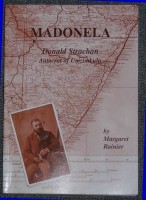 MADONELA is much more than a biography of Donald Strachan but is
a carefully researched and grippingly written account of the history of
Nomansland - that area of East Griqualand and southern Natal still causing such
political uncertainties. Donald Strachan's remarkable career as a pioneer in the
north-eastern Transkei involved him directly in most major events there during
the second half of the nineteenth century.
MADONELA is much more than a biography of Donald Strachan but is
a carefully researched and grippingly written account of the history of
Nomansland - that area of East Griqualand and southern Natal still causing such
political uncertainties. Donald Strachan's remarkable career as a pioneer in the
north-eastern Transkei involved him directly in most major events there during
the second half of the nineteenth century.
This phase of the South African past still awaits close scrutiny by professional historians. There can however be no doubt that one essential theme emerges from Strachan's life. It is the age-old quest to establish a balance between order and anarchy, control and freedom, justice and mercy.
Strachan, in his time as trader, farmer, Griqua and colonial magistrate, commander of black and white military forces, Cape parliamentarian and progenitor of an extensive family, dominated a complex community in which other strongly individualistic men co-operated, competed, failed or prospered, and the record of his career bears testimony to his endeavour. He and his elder brother came to Natal in 1850 as children in the Byrne settlement scheme. Orphaned shortly afterwards, they crossed the southern border into Nomansland before the arrival there of the Griqua trekkers under Kaptyn Adam Kok, with whom they were to become closely associated.
Among other contemporaries of theirs in the region were Nehemiah Moshesh (Sekonyana), son of Moshoeshoe the creator of the Basotho nation; Henry Callaway, bishop and medical practitioner; Charles Brownlee, and Walter Stanford his successor as Chief Magistrate of East Griqualand and as Secretary for Native Affairs; Joseph Orpen, Irish-born politician and land surveyor; Abbot Frans Pfanner, founder of the Mariannhill monastic order; Le Fleur the Griqua intriguer; Bhaca, Nthlangwini and Xesibe chieftains; Mqikela the Mpondo paramount, and Mhlangaso his principal rival before the annexation of their country by Great Britain.
This narrative of Strachan's life, based upon contemporary records, both personal and official, supplemented by oral tradition, does not offer any detailed analysis of general issues dominating the wider scene. Instead it seeks to establish the course of developments, dramatic though now partly forgotten, in which Strachan played an active role, many of which contributed to the evolution of modern South Africa.
Despite her death in March of 2002, the publication of the book has been completed by Margaret's family and friends but without the final benefit of her vast and detailed knowledge.
Title: MADONELA DONALD STRACHAN: AUTOCRAT OF UMZIMKULU v+361 Pages, A5 size, 7 b+w photographs, 1 map, soft cover, with notes, principal sources of information and fully indexed
Send the order form to: Mr J Rainier, 14 Bertha Ave, Claremont 7708 RSA or email John